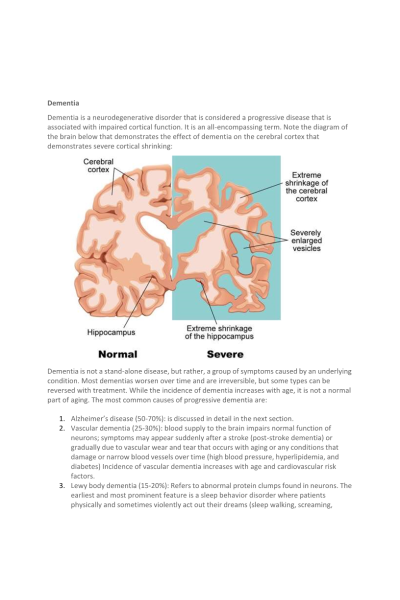NR 507 Week 7 Assignment; CNS; Sensory and Motor Disorders (E-dapt Content)
-
$29.00
| Institution | NR 507 Advanced Pathophysiology |
| Contributor | Laura Palmer |
Dementia
Dementia is a neurodegenerative disorder that is considered a progressive disease that is associated with impaired cortical function. It is an all-encompassing term. Note the diagram of the brain below that demonstrates the effect of dementia on the cerebral cortex that demonstrates severe cortical shrinking:
Dementia is not a stand-alone disease, but rather, a group of symptoms caused by an underlying condition. Most dementias worsen over time and are irreversible, but some types can be reversed with treatment. While the incidence of dementia increases with age, it is not a normal part of aging. The most common causes of progressive dementia are:
- Alzheimer’s disease (50-70%): is discussed in detail in the next section.
- Vascular dementia (25-30%): blood supply to the brain impairs normal function of neurons; symptoms may appear suddenly after a stroke (post-stroke dementia) or gradually due to vascular wear and tear that occurs with aging or any conditions that damage or narrow blood vessels over time (high blood pressure, hyperlipidemia, and diabetes) Incidence of vascular dementia increases with age and cardiovascular risk factors.
- Lewy body dementia (15-20%): Refers to abnormal protein clumps found in neurons. The earliest and most prominent feature is a sleep behavior disorder where patients physically and sometimes violently act out their dreams (sleep walking, screaming,laughing, kicking, punching). It is a REM sleep disorder with failure to inhibit movement during sleep. There can also be visual hallucinations; memory loss may not be noticeable until later stages. Dementia caused by advanced Parkinson’s disease dementia belongs in this group and will be discussed later in more detail.
- Frontotemporal dementia: is another common type of progressive dementia. It is characterized by neuronal cell death in the frontal and temporal lobes of the brain. The areas associated with this relates to behaviors and language. Common signs and symptoms include changes in behaviors (social inappropriateness, impulsivity, apathy, emotional indifference) and language deficits This type has a strong genetic component and tends to occur earlier between the ages of 40-50 years.
More than one type of the dementias mentioned above may co-exist in one patient (mixed dementia).
Less common causes of dementia include Huntington’s disease, Creutzfeldt-Jakob disease and traumatic brain injuries.
Dementias may also develop from metabolic and endocrine processes such as thyroid disorders and vitamin deficiencies (B1, B6, B12) or infections like Lyme disease and neurosyphilis. For these types of dementias, symptoms can be reversed................ Continue
| Instituition / Term | |
| Term | Year 2022 |
| Institution | NR 507 Advanced Pathophysiology |
| Contributor | Laura Palmer |





































